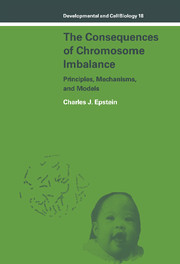Book contents
- Frontmatter
- Contents
- Preface
- Glossary
- PART I INTRODUCTION
- PART II CLINICAL OBSERVATIONS
- PART III THE THEORETICAL MECHANISMS AND ISSUES: THE PRIMARY AND SECONDARY EFFECTS OF ANEUPLOIDY
- 4 Gene dosage effects
- 5 Metabolic pathways, transport systems, and receptors
- 6 Regulatory systems
- 7 Assembly of macromolecules, cellular interactions, and pattern formation
- 8 Type and countertype
- 9 Nonspecific effects of aneuploidy
- PART IV EXPERIMENTAL SYSTEMS FOR THE STUDY OF MAMMALIAN AND HUMAN ANEUPLOIDY
- PART V THREE MAJOR CLINICAL PROBLEMS OF HUMAN ANEUPLOIDY
- PART VI CONCLUSION
- Appendix: Standard karyotypes of man and mouse and human cytogenetic nomenclature
- References
- Index
4 - Gene dosage effects
Published online by Cambridge University Press: 14 October 2009
- Frontmatter
- Contents
- Preface
- Glossary
- PART I INTRODUCTION
- PART II CLINICAL OBSERVATIONS
- PART III THE THEORETICAL MECHANISMS AND ISSUES: THE PRIMARY AND SECONDARY EFFECTS OF ANEUPLOIDY
- 4 Gene dosage effects
- 5 Metabolic pathways, transport systems, and receptors
- 6 Regulatory systems
- 7 Assembly of macromolecules, cellular interactions, and pattern formation
- 8 Type and countertype
- 9 Nonspecific effects of aneuploidy
- PART IV EXPERIMENTAL SYSTEMS FOR THE STUDY OF MAMMALIAN AND HUMAN ANEUPLOIDY
- PART V THREE MAJOR CLINICAL PROBLEMS OF HUMAN ANEUPLOIDY
- PART VI CONCLUSION
- Appendix: Standard karyotypes of man and mouse and human cytogenetic nomenclature
- References
- Index
Summary
Based on the analysis of the available clinical information, it can be concluded that there is a definite relationship between the identity and therefore the genetic structure of an unbalanced chromosomal region and the phenotypic consequences resulting from its imbalance. Not all regions affect the phenotype equally, and interactions between different unbalanced regions clearly exist. The existence of a quantitative relationship between the degree of genetic imbalance of a specific region and the resulting phenotype is indicated by the results of comparing the phenotypes of tetrasomies with those of their corresponding trisomies. Overall, the clinical data, while pointing to the possible complexity of interactions between and among the products of several different simultaneously unbalanced genes and of the balance of the genome, support the basic premise advanced in the first chapter – that it should be possible to relate the phenotypic effects of an aneuploid state to the cumulative effects of the imbalance of specific loci and sets of loci and ultimately to discover how the loci and the phenotypic effects are connected. Therefore, in this part of the book, I shall use both theoretical and experimental considerations to suggest how imbalance of genes can actually lead to phenotypic alterations.
Central to an understanding of the mechanisms by which aneuploidy produces its consequences is the concept of gene dosage effects. This concept holds that the synthesis, and hence the concentration, of a primary gene product is directly proportional to the number of genes coding for its synthesis.
- Type
- Chapter
- Information
- The Consequences of Chromosome ImbalancePrinciples, Mechanisms, and Models, pp. 65 - 84Publisher: Cambridge University PressPrint publication year: 1986
- 2
- Cited by



